Discovery Apple Trees
Honest Delivery Prices- Use: Eating. Sweet, crisp, touch of strawberry.
- Partial Tip Bearer: suitable for fans more than cordons or espaliers, trained on wires.
- Average vigour. Upright / Compact / Spreading form.
- Self sterile. Pollination Group C.
- Recommended for the North & Scotland
- Frost resistant flowers
- Harvest: Mid to late August.
- Store & ripen 2-3 weeks.
Description
Discovery Apple Trees, Eating
The Discovery apple tree produces an early season eating apple.
Along with Beauty of Bath, this special apple is one of our favourite early cropping varieties. It has excellent texture and flavour: crisp, juicy and sweet. The taste is light, with a dash of fruity, strawberry like aromas and it is lovely when it is eaten from the fridge on a hot day. It is a pale yellow-green colour, ripening to red where the sun hits it.
Like most early season apples, Discovery doesn't store well, so we suggest that you estimate how many of them you'll eat in about 2 weeks and press the rest into juice to refrigerate or freeze.
The tree's compact size makes it ideal for smaller gardens. It is often slow to start its cropping life, but mature trees produce reliable yields.
Browse our range of apple trees, or all our fruit trees.
Read our guide to buying apples.
Delivery season: Bareroot plants are delivered in late Autumn to Spring, about November-March inclusive. Pot grown plants, year round.
Features:
- Use: Eating. Sweet and crisp, with a fine flavour that has a touch of strawberry.
- Partial Tip Bearer: suitable for fans more than cordons or espaliers, trained on wires.
- Average vigour. Upright / Compact / Spreading form.
- Self sterile. Pollination Group C.
- Recommended for the North and Scotland
- Frost resistant flowers
- Harvest: Mid to late August.
- Store & ripen in a cool, dry place: Use within 2-3 weeks.
Growing Discovery Apples
Apples like rich, well drained soil, and will thrive on clay in locations that do not get waterlogged in winter.
A full day of sun and shelter from the wind is ideal.
Rootstocks:
We use MM106 for Discovery, the UK standard for medium-sized trees, ideal for gardeners. It gives a half-standard about 4m tall, and a bush about 3m.
MM106 maidens are suitable for cordons and espaliers, but we use the less vigorous M9 for our ready-made cordons, and M26 for bushes unless otherwise noted.
This tree is potentially suitable for organic growing in the more humid West and South of Britain, where scab and canker are more common. It is recommended for the North & Scotland because of its frost resistant flowers.
Disease notes:
Disease resistance: Scab
Prone to spider mite.
Pollination Partners for Discovery
Your trees are self sterile and their flowers must be pollinated to make fruit.
Discovery is in Pollination Group C, which cross-pollinates with other apple trees in Groups B, C and D.
Use our Fruit Pollination Checker to quickly find pollination partners, or Apple Tree Pollination Guide to learn more.
Planting Instructions
Notes on planting apple trees:
All fruit trees like a rich soil with decent drainage, protection from the wind and plenty of sun. Apple trees like clay soil, as long as it is not prone to bad waterlogging.
Prepare your site before planting:
Improving the soil helps trees establish quickly and be productive for years. Preparing weeks or months in advance gives best results: fill the planting hole back up, don't leave it open to either dry out or fill with water.
Do not plant less than 30cm from a wall.
- Destroy weeds and grass,
- Dig the soil over in a square of at least 1 metre, remove stones, then mix in well rotted compost or manure down to the depth of about 2 spades, unless you are on heavy clay:
- On thick clay soil, only dig over the soil to break it up. Apply organic matter as a mulch over the soil after planting.
Soak the tree roots in water for about an hour before planting.
Spacing apple trees:
- Freestanding bushes: 15-18 feet (5-6m) between trees and rows.
- Freestanding half-standards: 18-30 feet (6-10m) between trees and rows.
In general, allow 1 more metre between rows than between trees along the row.
- Wire-trained cordons: 60-100cm apart along a row.
- Espaliers: 10-18 feet (3.5-6m) apart.
- Watch how to plant a fruit tree for a bush or half-standard.
- To grow a cordon or espalier, you need to install sturdy training wires.
Water well after planting, mulch the dug over area, and water weekly through the first summer.
Pruning apple trees:
- Maidens can be pruned in any style, including into bushes or half-standards.
- Bushes - start here when you buy a bush.
- Half-standards - start here when you buy a half-standard.
Accessories:
For bush and half standard apple trees, a tree planting pack, which includes a wooden support stake & rubber tie (a bamboo cane is enough support for a maiden), and a biodegradable mulch mat, with pegs, to preserve soil moisture stops and prevent weeds.
We strongly recommend using mycorrhizal "friendly fungi" on the roots of all transplanted trees.
Winter wash and grease are effective, organic pest prevention.
Did You Know?
This tree was grown from a Worcester Pearmain apple by Mr Drummer, shortly after the Second World War. It was called Thurston August until J. Matthews began producing it in 1962.
It is often disappointing when you buy it in the shops because it's harvested too early, a real poor use of a fine variety.
Apple Tree Delivery Shapes:
Most of our fruit trees are delivered in up to 3 shapes (maiden, bush, and half standard), scroll up to see what's in stock.
Maiden:Unbranched tree, the most basic starting size, which you can train into the other forms (apart from mini patio trees).
Bush: Freestanding tree with a short trunk about 60cm tall. It will grow to about 3m. Ideal for small gardens.
Half-Standard: A freestanding form with a trunk about 120cm tall. It will grow into a full sized, "normal" apple tree, about 4m. Ideal for orchards, easy to mow underneath.
Cordon: Discovery is more of a tip-bearer than a spur bearer, so not the best for cordons and espaliers, but a fan (which has more tips) would be fine.
Guide to Fruit Tree Sizes.
7.5 - 12 litre Potted Trees: These trees are not meant to be kept in pots. They will be fine for up to 12 months (until planted in the ground) as long as they are well watered (but not over watered).Patio fruit trees: Recommended for growing in large patio containers and can be kept in pots.

 Img 5.webp)
 Img 5.webp)



 blossom bud Img 4.webp)

 blossom Img 2.webp)
 Img 3.webp)